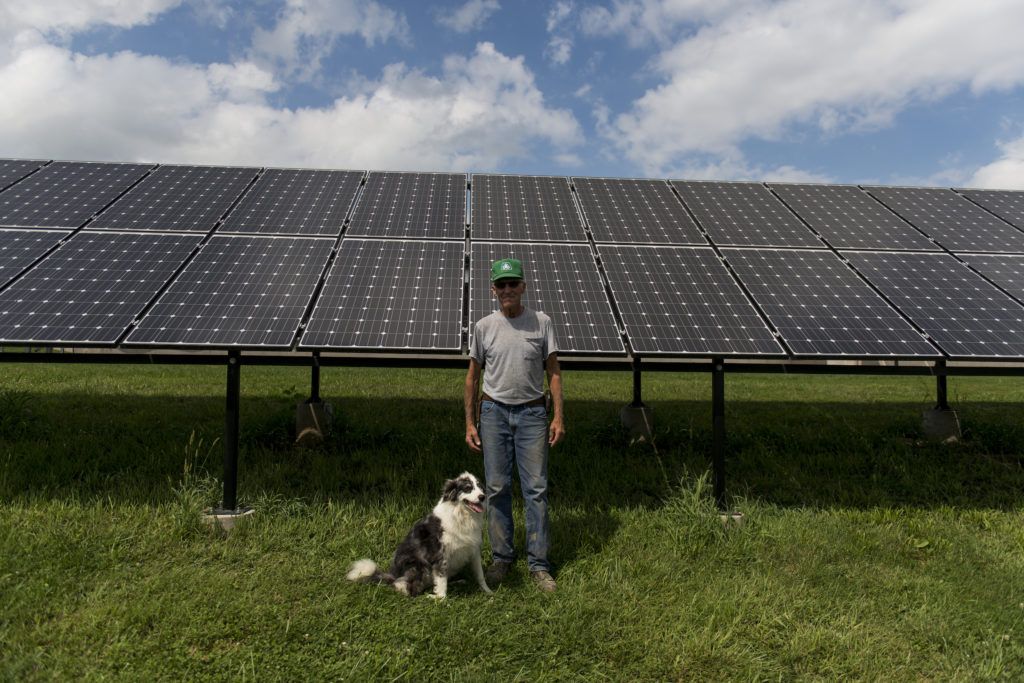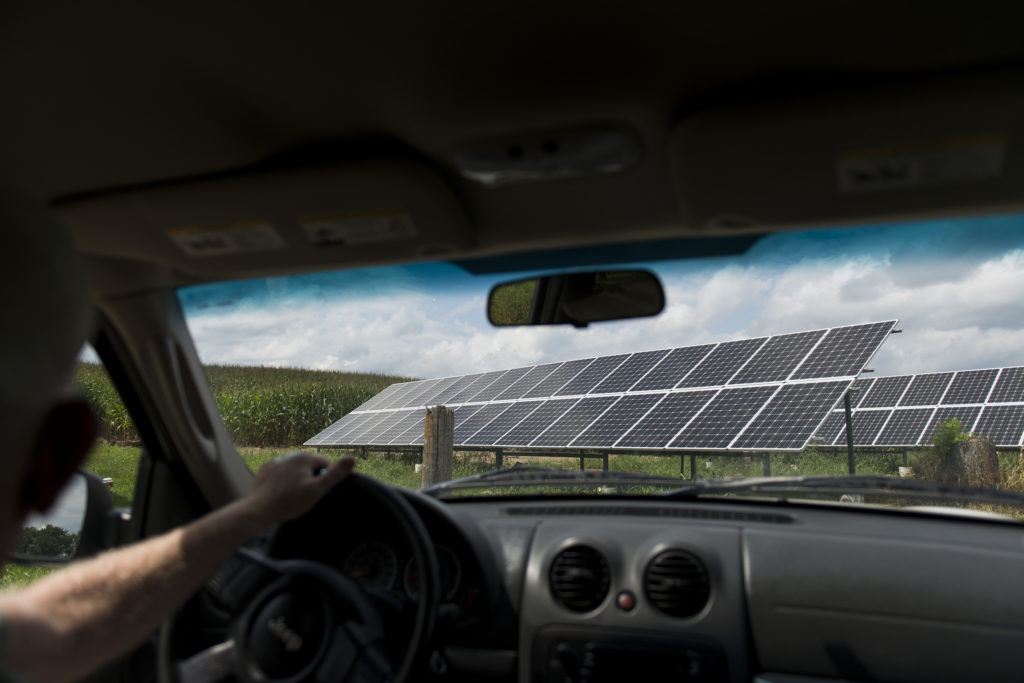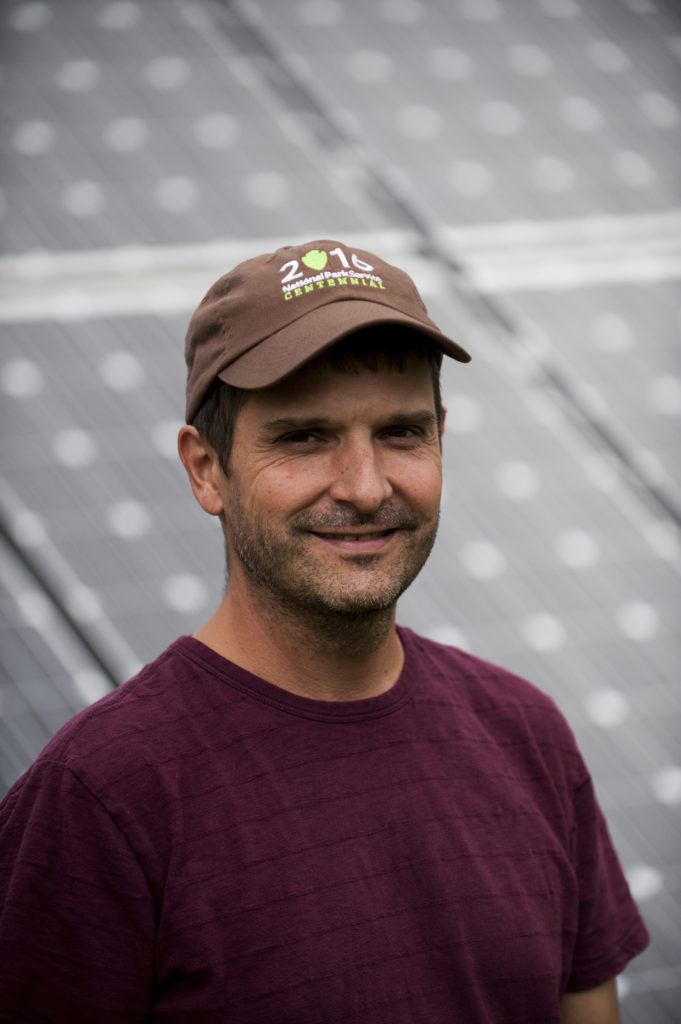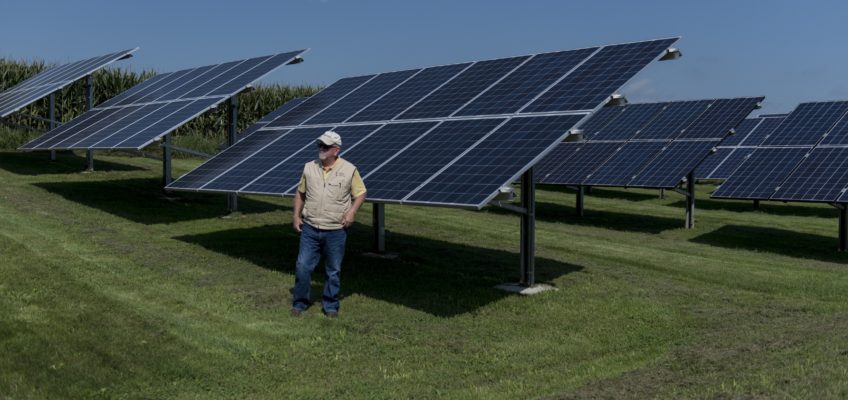It’s hard to imagine a place more bucolic than the rural farming communities clustered around Kalona, Iowa — the kind of place that for generations has embodied conservative, blue-collar values woven throughout rural America.
Nestled in the gently rolling hills of southeastern Iowa, it’s at first difficult to tell what sets Kalona apart from countless similar places on the Midwestern landscape. Small towns like these form the backbone of a region whose economy depends on a rich farming tradition, even well into the 21st century.
But Kalona’s charm doesn’t obscure the innovation that makes it a national leader in clean power generation. In this small community, where many Amish and Mennonite families shun electricity and cars, solar power has proliferated. In fact, the Kalona area is a surprising national leader in solar power generation.
Sparking Solar
The local solar movement traces back to Farmers Electric Cooperative, the utility serving 605 households and businesses in Kalona and its surrounding villages. Per capita, Farmers Electric generates 3,719 watts of solar power per subscriber — 76 percent more than the next utility! The utility, owned by its customers, offers a window into how community-minded thinking can shape sensible energy policy and reinvent the local economy.
Eight years after Farmers Electric launched a fierce campaign to integrate renewables into its energy mix, it’s obvious that solar has caught on. Skeptics were slow to opt in to clean power in the beginning. But now, in Kalona, solar power is the norm. They line the roofs of farmhouses and other local businesses, and ground-mounted arrays power other agribusiness operations.
What started with a single pilot array at a local high school has grown into a robust distributed generation network including farmers, homeowners and business owners cashing in on clean energy. Even as customers save money, more of their energy dollars stay within the community, boosting the local economy.
See our video of Farmers Electric excellent solar reality:
Farmers Electric remains an outlier in promoting solar so aggressively, but its approach provides a blueprint for other power providers.
“Solar is like the electric car. I think people see it as the future, basically, in technology,” said Warren McKenna, who heads up Farmers Electric and spearheaded its solar plan. “If you make it easy, I think they’re going to grab a hold of it. It’s been very, very popular with our customers.”
There is no single path to unlocking the economic and community benefits seeded by solar, captured widely in Farmers Electric’s territory. Still, the unexpected success in bringing widespread solar generation to a tiny farming community about 30 miles south of Iowa City offers a pivotal lesson: it all comes down to the money.
The Pitch
Farmers Electric harnessed the power of the dollar to gets its solar campaign off the ground, and keep it going. In order for the program to succeed, McKenna knew early on that it had to provide a financial boost to co-op members — the environmental benefits, he says, were an unspoken cherry on top.

To make it work, Farmers Electric fine-tuned a novel framework that allowed its members to buy and install solar panels at a reasonable rate. It needed to ensure its pricing, anchored by a pioneering feed-in tariff, would work with tax credits to cover the cost of solar investment within a timely window. Without a tangible payoff, the panels simply wouldn’t sell.
“You can say whatever you want, but if it’s not going to pay within a short amount of time, they’re not going to buy it,” said Dick Yoder, an early local solar advocate who doubles as an electrician and high school physics teacher, and moonlights as Kalona’s primary solar installer.
Yoder latched onto green energy in the 1980s, but back then his neighbors dismissed him. But that all changed when Farmers Electric made the financial case for solar, sidestepping more polarizing sustainability concerns. Panels began to pop up throughout the Kalona area, birthing Yoder’s thriving solar-installation business.
“They’d see someone put it in,” Yoder said, “and they’d say, ‘Maybe it’s a good idea.’”
Overcoming Skepticism
The board that runs Farmers Electric, comprised entirely of older men who work in agriculture, at first raised questions over how solar would mesh with the utility’s traditions and business model. When McKenna first floated the idea in 2008, the cost of materials and installation was higher, and deep-seated community values prioritized industry — namely farming — over sustainability.
But by framing solar as a can’t-miss financial opportunity, with the numbers to back up his case, McKenna chipped away at the skepticism. Farmers Electric, joining its novel feed-in tariff with other incentives — among them a rebate, plus state and federal programs — virtually ensured solar would pay off in short order, and then some.
The feed-in tariff and a companion rebate program were initially adjusted for the average cost of solar in 2008 — $5.50 per watt. That calculus set the tariff at $0.20 per kilowatt-hour. The utility has since adjusted incentives to reflect a precipitous decline in the cost of solar, ultimately phasing out the rebate program and reducing its feed-in tariff to $0.06 per kilowatt-hour. But with the cost of solar hovering below $2.30 per watt, and state incentives available, Farmers Electric customers continue to buy in.
“There are skeptical people in all this, and then when the skeptics come in and put solar in, that’s when you have the ‘Aha’ moment,” McKenna said. “It’s making it work, and turning people on [to the fact] that it can work.”
Today, just one holdout board member doesn’t support solar. McKenna blames his resistance on the misguided idea that installing solar is a political statement. But the others, many of them in charge of industrial-grade farms of their own, made solar power a part of their operations and have since seen significant results.

Keith Troyer, a turkey and hog farmer who has sat on the Farmers Electric board for nearly two decades, tucked one of the area’s largest single solar arrays behind one of his barns. Given the relative simplicity of solar power generation and steep financial upside, he pounced.
“It’s reduced my electric bill, it’s paying for itself quite rapidly,” Troyer said, eyeing his array on a very hot — and very sunny — August day. “I am just
really tickled with what it has been doing and how it has been performing kilowatts-wise. It’s probably exceeded what I thought it maybe would do.”
In response to enthusiasm for solar, Farmers Electric has expanded its suite of offerings to include sizable solar projects, allowing its member-owners without on-site sunshine to cash in. The utility’s portfolio includes an 800-kilowatt array, a 950-kilowatt array, and a 50-kilowatt solar garden with 127 subscribers.
Solar garden subscribers purchase up to 10 panels and then see monthly bill credits based on the generation at the site, spreading benefits of solar generation to member-owners unable or unwilling to put panels on their homes or in their yards. The 265-watt panels currently go for $475 apiece (less than $2 per watt).
Farmers Electric offers periodic promotions to get its member-owners on board. After an expansion last year, the utility’s farms generate enough solar energy to power more than 200 homes for a year — a big step forward in its plan to generate 25 percent renewable power by 2025.
The utility’s growing solar generation traces back to pivotal approvals from its board more than a half-decade ago. Barry Shearer, the former healthcare executive who backed the initial solar farm through his Eagle Point Solar outfit, said the project hinged on a finely crafted economic argument.
“The environmental attributes, which are are much more important drivers to me personally, are secondary in the sales pitch,” he said. “We don’t know what anybody’s temperature is going to be, about whether they’re climate change believers, climate change deniers, whether they believe that human activities are impacting the planet. That’s too long of a discussion.”
“Revenue-Neutral”
The feed-in tariff is the central piece of Farmers Electric’s approach to solar. Modeled loosely after successful policy in Germany, it ensures customers generating their own solar have two meters — one that tracks energy consumption, and another that tallies solar output. Customers’ energy use is offset by a bill credit for their generation.
Feed-in rates for distributed solar generation vary based on when a system first linked to the grid. On average, solar-generating customers see roughly $0.138 per kilowatt-hour. That beats the current retail rate of $0.125 per kilowatt-hour, and the average feed-in rate is expected to outpace retail for a few more years. In rare cases where monthly production outstrips consumption, the rate is set at $0.06 per kilowatt-hour. Very few arrays post a net surplus annually.
The tariff payments appear as line-items on monthly bills, which McKenna says encourages people to pay attention to notice the benefits of solar. Those payouts are covered in part by voluntary customer contributions to a utility-run green power program that counts more than 10 percent of Farmers Electric customers among its participants.
Carefully crafted incentives were designed to fit neatly within Farmers Electric’s business model, to lay a solid foundation for solar growth without imposing outsize financial risk on the utility or its customers.

“We remained revenue-neutral,” McKenna said. “A huge amount of work goes into making sure that we can do these projects and make sure they’re revenue-neutral, but [we’re] using a lot of creative ways to do that.”
The first Farmers Electric solar farm, situated adjacent to the utility’s small office in the middle of far-reaching corn fields, is part-owned by Eagle Point Solar, the Iowa solar-investment outfit launched by Shearer. When Shearer wanted to dip into the solar market back in 2010, McKenna was one of a few willing partners.
“It was groundbreaking,” Shearer said of Farmers Electric’s ambitious renewables plan. “There was nothing on the horizon in Iowa that was like it. It took courage on the part of Warren and his Farmers Electric board of directors to do that and it has paid off.”
Under their agreement, Eagle Point initially owned half the project, collecting a monthly payment from Farmers Electric plus the tax credits tied to the farm. After 10 years, the utility will own the project outright.
“It’s been a successful experiment for Farmers Electric and Warren, because most of the time when they hit their demand peak, the solar array is producing and therefore reducing the demand peak,” Shearer said. “That’s truly where the economics come into play.”
In addition, more on-site generation by customers has reduced Farmers Electric’s transmission costs. The utility also receives about $12,000 per month for the pair of 2-megawatt diesel generators that sit largely dormant in a facility tucked behind its office — money that helps back its solar business.
Farmers Electric spent $2 million on the “peaking” generators, which kick on when the regional power system is strained. That translates to about 10 hours of run-time per year, McKenna said. The generators, he says, allow more flexibility in building out distributed generation, like the customer-owned solar, by ensuring both financial support for Farmers Electric programming and logistical support for the grid — even though it diverges from the renewable-centric growth at the heart of the utility’s plans.
“It’s a lot of money just for having it here,” he said.
On today’s grid, peaking generation is a mainstay. For Farmers Electric, the opportunity to draw from a local power source — even if it wasn’t solar — presented an opportunity to keep more of the utility’s business in the confines of the community it serves.
“We wanted to own that rather than purchase it on the market,” McKenna said. “It’s just like solar — either you own it or the big boys own it. We decided we wanted to own it, and our model allowed for that.”
Local Self-Reliance
In making the economic case for solar generation, Farmers Electric tapped into a guiding principle that runs deep through its community’s heritage. The agriculture industry that dominates Kalona’s regional economy favors local control.

“Our vision was, when we initially started with renewables, not only to reduce power bills but to keep the money in the community,” he said. “Solar has allowed us to buy local, from local producers, basically. Our model’s based around that.”
Farmers and others in the agriculture industry “grasp that self-reliance more,” McKenna said, noting that a local farmer brings his sheep graze around the solar farm, a symbiotic relationship where the farmer feeds his flock for free and Farmers Electric saves on mowing expenses.
Local economic gains underscore the benefits of self-reliance, including through distributed solar generation. By reframing its business to focus heavily on local renewable generation, Farmers Electric keeps a greater portion of its member-owners’ energy spending within the community rather than sending it to out-of-town power producers.
“We know the money turns over more in the community, several more times,” McKenna said.
Local self-reliance guides the area’s notable Amish and Mennonite communities. While they traditionally do not use electricity in their homes or on their farms, some use on-site solar power to charge batteries that light their barns or power milking equipment, for example. Solar panels also power a network of phone booths in and around Kalona, available for the Amish.
“They like solar,” McKenna said. “They ask me, ‘How’s the solar doing?’ They’re keeping track of it.”
Economic Development
Demand for renewable generation is on the rise — not just among individuals, but for businesses as well. Farmers Electric, for its part, has taken notice. The utility’s uptick in solar dovetails with business growth in its territory. Creative deal-making underpins a two-way relationship between commercial outfits in town and Farmers Electric, with renewable energy linking the two.
The most eye-catching example sits on the fringe of large expanses of farmland, an industrial beacon jutting out from the pastoral landscape. There, a large plant sits on 25 acres. For years, it was a silent eyesore that struggled to stay afloat first as a slaughterhouse, then as a chicken processing facility. Now, after new owners’ cooperation with Farmers Electric, the facility is open with four businesses — all using solar — humming inside.
Farmers Electric jump-started the effort through an agreement to purchase a nine-acre swath of the property to house two solar farms, answering demand for more generation. The utility forked over $120,000 upfront, enabling egg producer Farmers Hen House and Kalona Organics to buy and revive the plant.
For the utility, the move meant more than expanding its solar business — it added customers. Where the shuttered facility had no electric bill, the load from the four businesses that now operate inside falls to an adjacent solar farm. The added load and revenue allows the solar farm to cash flow, keeping the project revenue-neutral for the broader benefit of Farmers Electric and its customer base.
Today, the solar generation allows Farmers Hen House to advertise 100 percent carbon-free operations on its egg cartons — a value-add as customers increasingly favor sustainable production. The company also serves as the partner Farmers Electric needs in order to capture tax credits for the solar farm.
Solar Success Breeds Action

It’s conventional wisdom in Farmers Electric territory that solar begets solar. What started with a flagship project at a local high school swelled into an energy self-reliance movement still spreading across Kalona and its neighboring villages. By installing solar at the school, McKenna said, residents and business owners could get a no-risk taste of why solar works and how.
“I think it’s changed the attitudes of people about renewable energy,” he said.
A few years ago, Matt Miller, a math teacher who lives with his family in Frytown, ran the numbers on installing a ground-mounted solar array in his backyard. State and federal incentives coupled with the utility payouts made switching to on-site generation a safe bet. During the sunniest part of last year, he said the installation had eclipsed his expectations.
“It’s actually doing a little better than I thought it would,” he said. “The payoff was supposed to be right around seven years, and I think I’m going to be well under that.”
Miller’s array stands in contrast to his home, which he says is one of the oldest farmsteads in Frytown. The aging property is in good shape, obscuring its age. But after integrating on-site solar generation, Miller said he became more attuned to other ways he could upgrade his home.
“There’s something interesting psychologically about these,” he said, looking up at his solar panels. “When I put these up, all of a sudden, I was like, ‘What else can we do?’”
To date, Miller has added insulation to his attic — one of the most affordable and effective, but least conspicuous, energy efficiency improvements a homeowner can make. He also took bigger steps, including installing a ductless heating and cooling system that further boosts his efficiency. That action, he says, was a product of seeing how well solar works.
“It becomes almost a hobby to see how efficient you can be,” Miller said.
The Future of Farmers Electric
Already, Farmers Electric produces 20 percent of its kilowatt-hours locally, McKenna said. The utility is on track to meet its benchmark of generating one-quarter of its power using renewables by 2025.
Going forward, McKenna said his work will focus on “aggressively pursuing” energy efficiency. Many customers, like Miller, tiptoe into energy-conserving improvements after installing solar panels and seeing the benefits.
For all Farmers Electric’s success, McKenna hasn’t lost sight of the people he serves. Their needs are paramount to the co-op’s mission by its very design, he says, though others around the country have been slower to adopt renewables as a pathway to cost savings and choice for their member-owners.
“Remember, we are a tiny co-op with a passion for solar,” McKenna said. “And the local support for it is phenomenal.”
This article originally posted at ilsr.org. For timely updates, follow John Farrell or Karlee Weinmann on Twitter or get the Energy Democracy weekly update.





